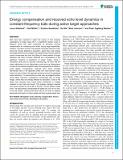Files in this item
Energy compensation and received echo level dynamics in constant-frequency bats during active target approaches
Item metadata
| dc.contributor.author | Stidsholt, Laura | |
| dc.contributor.author | Müller, Rolf | |
| dc.contributor.author | Beedholm, Kristian | |
| dc.contributor.author | Ma, Hui | |
| dc.contributor.author | Johnson, Mark | |
| dc.contributor.author | Madsen, P.T. | |
| dc.date.accessioned | 2021-01-28T00:37:34Z | |
| dc.date.available | 2021-01-28T00:37:34Z | |
| dc.date.issued | 2020-01-28 | |
| dc.identifier | 266431017 | |
| dc.identifier | 89f2d07a-b3b3-43dd-b5ed-14eb623560a0 | |
| dc.identifier | 85078685124 | |
| dc.identifier | 31836651 | |
| dc.identifier | 000541780500018 | |
| dc.identifier.citation | Stidsholt , L , Müller , R , Beedholm , K , Ma , H , Johnson , M & Madsen , P T 2020 , ' Energy compensation and received echo level dynamics in constant-frequency bats during active target approaches ' , Journal of Experimental Biology , vol. 223 , no. 2 , jeb217109 . https://doi.org/10.1242/jeb.217109 | en |
| dc.identifier.issn | 0022-0949 | |
| dc.identifier.uri | https://hdl.handle.net/10023/21338 | |
| dc.description | This work was supported by the Semper Arden Carlsberg grant to P.T.M., by a National Science Foundation grant [1658620] to R.M. and by a National Natural Science Foundation of China [11574183] to R.M. | en |
| dc.description.abstract | Bats have been reported to adjust the energy of their outgoing vocalizations to target range (R) in a logarithmic fashion close to 20log10R which has been interpreted as providing one-way compensation for increasing echo levels during target approaches. However, it remains unknown how species using high-frequency calls, which are strongly affected by absorption, adjust their vocal outputs during approaches to point targets. We hypothesized that such species should compensate less than the 20log10R model predicts at longer distances and more at shorter distances as a consequence of the significant influence of absorption at longer ranges. Using a microphone array and an acoustic recording tag, we show that the output adjustments of two Hipposideros pratti and one Hipposideros armiger do not decrease logarithmically during approaches to different-sized targets. Consequently, received echo levels increase dramatically early in the approach phase with near-constant output levels, but level off late in the approach phase as a result of substantial output reductions. To improve echo-to-noise ratio, we suggest that bats using higher frequency vocalizations compensate less at longer ranges, where they are strongly affected by absorption. Close to the target, they decrease their output levels dramatically to mitigate reception of very high echo levels. This strategy maintains received echo levels between 6 and 40 dB re. 20 µPa2 s across different target sizes. The bats partially compensated for target size, but not in a one-to-one dB fashion, showing that these bats do not seek to stabilize perceived echo levels, but may instead use them to gauge target size. | |
| dc.format.extent | 9 | |
| dc.format.extent | 1738114 | |
| dc.language.iso | eng | |
| dc.relation.ispartof | Journal of Experimental Biology | en |
| dc.subject | Atmospheric absorption | en |
| dc.subject | CF bats | en |
| dc.subject | Echo level | en |
| dc.subject | Intensity compensation | en |
| dc.subject | Microphone array | en |
| dc.subject | Source level | en |
| dc.subject | QH301 Biology | en |
| dc.subject | Ecology, Evolution, Behavior and Systematics | en |
| dc.subject | Physiology | en |
| dc.subject | Aquatic Science | en |
| dc.subject | Animal Science and Zoology | en |
| dc.subject | Molecular Biology | en |
| dc.subject | Insect Science | en |
| dc.subject | NDAS | en |
| dc.subject.lcc | QH301 | en |
| dc.title | Energy compensation and received echo level dynamics in constant-frequency bats during active target approaches | en |
| dc.type | Journal article | en |
| dc.contributor.institution | University of St Andrews. School of Biology | en |
| dc.contributor.institution | University of St Andrews. Scottish Oceans Institute | en |
| dc.contributor.institution | University of St Andrews. Sea Mammal Research Unit | en |
| dc.contributor.institution | University of St Andrews. Sound Tags Group | en |
| dc.contributor.institution | University of St Andrews. Bioacoustics group | en |
| dc.contributor.institution | University of St Andrews. Marine Alliance for Science & Technology Scotland | en |
| dc.identifier.doi | 10.1242/jeb.217109 | |
| dc.description.status | Peer reviewed | en |
| dc.date.embargoedUntil | 2021-01-28 |
This item appears in the following Collection(s)
Items in the St Andrews Research Repository are protected by copyright, with all rights reserved, unless otherwise indicated.

